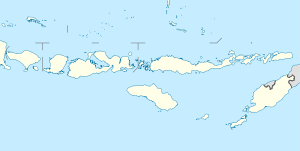Nunbena
| Kecamatan Nunbena Nunbena District
|
|
|---|---|
 |
|
| Basic data | |
| Country | Indonesia |
| province | East Nusa Tenggara |
| Administrative district | South Central Timor |
| Seat | Nunbena |
| surface | 134.5 km² |
| Residents | 5281 (2017) |
| density | 39 inhabitants per km² |
| ISO 3166-2 | ID-NT |
Coordinates: 9 ° 40 ′ S , 124 ° 7 ′ E
Nunbena is an Indonesian district ( Kecamatan ) in the west of the island of Timor .
geography
| "Village" (Desa) | Administrative headquarters | surface | Residents | Population density |
|---|---|---|---|---|
| Noebesi | Noebesi | km² | 1,388 | 30th |
| Lilana | Lilana | km² | 733 | 476 |
| Nunbena | Nunbena | km² | 901 | 28 |
| Taneotop | Taneotop | km² | 909 | 35 |
| Fetomones | Fetomones | km² | 662 | 66 |
| Tunbes | Tunbes | km² | 688 | 37 |
Location in East Nusa Tenggara Province
|
The district is located in the northwest of the administrative district of South Central Timor (Timor Tengah Selatan) of the East Nusa Tenggara Province (Nusa Tenggara Timur) . In the northeast lies the Fatumnasi district , in the southeast North Molo (Molo Utara) , and in the south West Molo (Molo Barat) . In the west, Nunbena borders the government district of Kupang with its districts Central Amfoang (Amfoang Tengah) and Takari .
Nunbena has an area of 134.49 km² and is divided into the six Desa Noebesi , Lilana , Nunbena , Taneotop , Fetomone and Tunbes . The administrative headquarters are in Nunbena. The Desas are divided into a total of twelve Dusubn (sub-villages). The villages of the district are located at an altitude of between 500 m and 800 m . As in Timor, the tropical climate is divided into a rainy and a dry season . Most of the rain falls in February while December is dry. In 2016, a rainfall of 1333 mm per square meter was measured.
flora
In the district there are occurrences of Vachellia leucophloea ( Indonesian Kabesak ), tamarind, teak and eucalyptus.
Residents
In 2017 there were 5,281 inhabitants in 1,310 households in Nunbena. 2,624 were men, 2,657 women. The population density was 39 people per square kilometer. There was one Catholic and ten Protestant churches and chapels in the district.
Economy, infrastructure and transport
Most of the district's residents make a living from agriculture. Cattle (4,707), horses (four), pigs (4,449), goats (731) and chickens (9,066) are kept as pets. Corn is grown on 1,172 hectares and rice on 113 hectares. Other agricultural products include avocados, mangoes, tangerines, papayas, bananas and jackfruits.
There are eight primary schools, two middle schools and two secondary schools in Nunbena. A community health center ( Puskesmas ), a medical care center ( Puskesmas Pembantu ) and a midwifery center ( Polindes ) are available for medical care . Doctors are not based in the district. Care is taken by five midwives, six nurses and five other people with medical training.
Web links
- Statistical data from Nunbena District 2018 (Indonesian).

